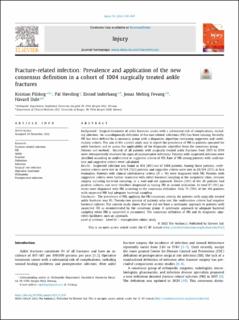| dc.contributor.author | Pilskog, Kristian | |
| dc.contributor.author | Høvding, Pål | |
| dc.contributor.author | Inderhaug, Eivind | |
| dc.contributor.author | Fevang, Jonas Meling | |
| dc.contributor.author | Dale, Håvard | |
| dc.date.accessioned | 2023-08-16T12:29:22Z | |
| dc.date.available | 2023-08-16T12:29:22Z | |
| dc.date.created | 2023-03-30T14:58:43Z | |
| dc.date.issued | 2023 | |
| dc.identifier.issn | 0020-1383 | |
| dc.identifier.uri | https://hdl.handle.net/11250/3084407 | |
| dc.description.abstract | Background
Surgical treatment of ankle fractures comes with a substantial risk of complications, including infection. An unambiguously definition of fracture-related infections (FRI) has been missing. Recently, FRI has been defined by a consensus group with a diagnostic algorithm containing suggestive and confirmatory criteria. The aim of the current study was to report the prevalence of FRI in patients operated for ankle fractures and to assess the applicability of the diagnostic algorithm from the consensus group.
Patients and methods
Records of all patients with surgically treated ankle fractures from 2015 to 2019 were retrospectively reviewed for signs of postoperative infections. Patients with suspected infection were stratified according to confirmatory or suggestive criteria of FRI. Rate of FRI among patients with confirmatory and suggestive criteria were calculated.
Results
Suspected infection was found in 104 (10%) out of 1004 patients. Among those patients, confirmatory criteria were met in 76/104 (73%) patients and suggestive criteria were met in 28/104 (27%) at first evaluation. Patients with clinical confirmatory criteria (N = 76) were diagnosed with FRI. Patients with suggestive criteria were further examined with either bacterial sampling at the outpatient clinic, revision surgery including bacterial sampling, or a wait-and-see approach. Eleven (39%) of the 28 patients had positive cultures and were therefore diagnosed as having FRI at second evaluation. In total 87 (9%) patients were diagnosed with FRI according to the consensus definition. Only 73 (70%) of the 104 patients with suspected FRI had adequate bacterial sampling.
Conclusion
The prevalence of FRI, applying the FRI-consensus criteria, for patients with surgically treated ankle fractures was 9%. Twenty-two percent of patients who met the confirmatory criteria had negative bacterial cultures. The current study shows that we did not have a systematic approach to patients with suspected FRI as recommended by the consensus group. A systematic approach to adequate bacterial sampling when FRI is suspected is paramount. The consensus definition of FRI and its diagnostic algorithm facilitates such an approach. | en_US |
| dc.language.iso | eng | en_US |
| dc.publisher | Elsevier | en_US |
| dc.rights | Navngivelse 4.0 Internasjonal | * |
| dc.rights.uri | http://creativecommons.org/licenses/by/4.0/deed.no | * |
| dc.title | Fracture-related infection: Prevalence and application of the new consensus definition in a cohort of 1004 surgically treated ankle fractures | en_US |
| dc.type | Journal article | en_US |
| dc.type | Peer reviewed | en_US |
| dc.description.version | publishedVersion | en_US |
| dc.rights.holder | Copyright 2022 The Author(s) | en_US |
| cristin.ispublished | true | |
| cristin.fulltext | original | |
| cristin.qualitycode | 1 | |
| dc.identifier.doi | 10.1016/j.injury.2022.12.030 | |
| dc.identifier.cristin | 2138590 | |
| dc.source.journal | Injury | en_US |
| dc.source.pagenumber | 841-847 | en_US |
| dc.identifier.citation | Injury. 2023, 54 (3), 841-847. | en_US |
| dc.source.volume | 54 | en_US |
| dc.source.issue | 3 | en_US |

